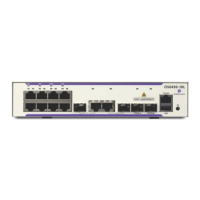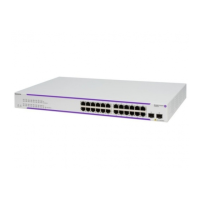OmniSwitch OS6860/OS6900/OS10K Troubleshooting Guide Part No.032996-00 Rev.A
AOS Release 7.X and 8.X January 2015
Alcatel-Lucent Page 44 of 148
Bytes Received : 89352, Unicast Frames : 20,
Broadcast Frames: 0, M-cast Frames : 1368,
UnderSize Frames: 0, OverSize Frames: 0,
Lost Frames : 0, Error Frames : 0,
CRC Error Frames: 0, Alignments Err : 0,
Tx :
Bytes Xmitted : 20064, Unicast Frames : 0,
Broadcast Frames: 0, M-cast Frames : 311,
UnderSize Frames: 0, OverSize Frames: 0,
Lost Frames : 0, Collided Frames: 0,
Error Frames : 0
If the problem is determined to be layer 2 data loop, it is recommended to disable all redundant links either
administratively or by disconnecting cables.
7.2. Advanced Troubleshooting
Useful Checklist for spanning tree problems
Make sure that all devices are running the same STP mode (1x1, FLAT, MSTP).
If Auto Fabric is enabled then spantree mode is forced to flat.
If using MSTP check if all devices are using the same domain name.
If using MSTP all VLANs within an MSTI must be tagged on all interswitch links otherwise MSTP
becomes unpredictable.
If using MSTP all switches participating in the same region must have an identical MSTP
configuration.
Check latency and connectivity loss is from layer 2 or layer 3 using ping.
Use show mac-address-table count to verify flushing and re-learning of MAC addresses on switch.
Check whether spanning tree in flat or 1x1 mode using "show spantree".
Determine root-bridge and make sure that it's on the right bridge.
Use stpni_printStats to verify on which ports TCNs and Flag01 counters are incrementing on each NI
(stpni_printStats may be cleared).
Restrict TCNs on ports where Rx counters for TCN and/or Flag01 are incrementing.
PVST+ BPDUs are affected (dropped in MC-LAG and qos user-port) only in case AOS is explicitely
configured in 1x1 PVST+ mode.
Disputed State
A port in STP will be in "Disputed" state, when a port which is receiving an inferior STP BPDU (low priority)
even in learning state. This means that even after a switch sends a higher priority BPDU, if it then continues to
receive a lower priority STP BPDU that port will move to "Disputed" state and will be in a "Listening" state.
In this state, no traffic is allowed through this port and "show vlan port" CLI, which will be in blocking state.
This will not make the port link go down. Only the VLAN will be in blocking state.
To Enable detailed logs in SWLOG in case of unexpected STP state
swlog output flash-file-size 12500
swlog appid portMgrCmm subapp all level debug2
swlog appid intfCmm subapp all level debug2
swlog appid VlanMgrCmm subapp all level debug2
swlog appid portMgrNi subapp all level debug2
swlog appid VlanMgrNi subapp all level debug2
Toggle the port state to recreate the issue. Reduce the logging level to ‘info’ and gather SWLOG outputs:

